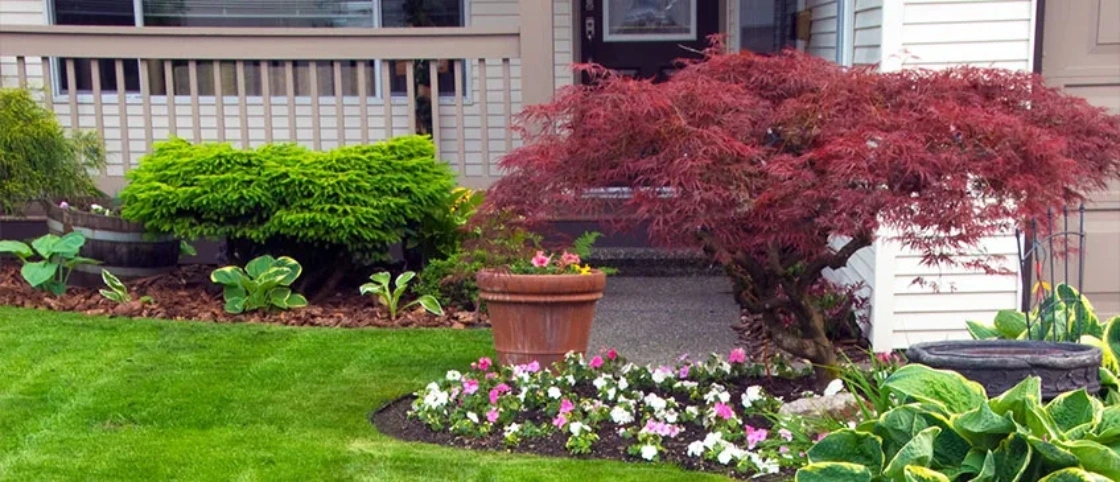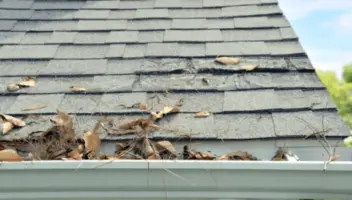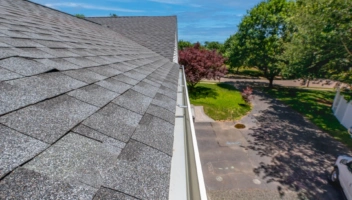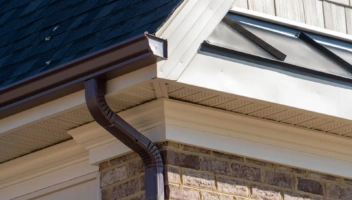Best Gutter Alternatives for Homeowners

Rain, rain, go away, the saying goes, but there’s not much we can do about the wet stuff falling from the sky. What you can and should do, though, is think about what happens to that water once it’s there. Gutter systems are a traditional way to handle the rainwater spilling off your rooftop, whisking the water away from your home’s foundation. Managing this waterflow is an important part of home maintenance, but gutters are not always the best option or enough for every homeowner.
Rain gutter alternatives and additions like rain chains, French drains, and drip edge systems can help channel the water in more environmentally-friendly and aesthetically-pleasing ways. With so many options and variables to consider, you need to know what’s best for your living situation. Read on to learn the ins and outs of gutters and gutter alternatives so you can do what is right for your home.
In this article:
- Popular Gutter Alternatives
- Eco-friendly Gutter Alternatives
- Factors to Consider When Choosing Gutter Alternatives
Importance of Rainwater Management
Rain falls all the time, so you may wonder what harm a little water can really do. It turns out, however, that improper water management can cause significant damage and safety concerns over time. Water seeping into your home’s foundation can lead to mold and mildew, pest infestations, rotting wood, and many other problems that can cost you dearly if left unattended.
The most common way for water to find its way into your home is through rain runoff, especially in areas where the soil struggles to absorb water. For instance, areas in the American South have lots of impermeable red clay, which can lead to water pooling. This is why gutters and gutter alternatives are so important. Without them, the rain drips off of your roof and collects right next to your walls where it can easily seep into foundations and basements. No matter what method you pick, you need a way to wrangle the rainwater.
Traditional Gutters: Pros and Cons
Traditional gutters are a staple option since they are simple, effective, and affordable. Gutters are simply channels that run along the edge of your roof, collecting rainwater and funneling it through downspouts that direct the water away from your home. Since they are such a simple concept, gutters can often be installed by DIYers in a short time. However, there are some downsides to consider with gutters, too.
Improperly installed gutters can cause more harm than good. Gutters need to be sloped just right to promote proper drainage, and if the installation isn’t right or if wear and tear mess with the alignment, gutters may end up overflowing or pooling water in heavy rain. This can lead to water seeping into the foundation or creating breeding pools for pests like mosquitos. So, proper gutter installation is essential to prevent this issue..
Popular Gutter Alternatives
Rain Chains
A good transition away from traditional gutters and downspouts is the decorative rain chain. This system still has gutters running along the edges of the roof, but the downspouts are replaced by intricate “chains” of cups, buckets, tubes, and the like. These function identically to a downspout, but they evolve rainy days into beautiful water features, adding a bit of style to water management.
Of course, rain chains are more expensive than typical downspouts since they are more intricate and stylish. With those nifty shapes and designs, maintenance, too, becomes a bit more of an issue. You’ll need to keep an eye out for blockages and bits of debris to ensure that the water makes it all the way to the ground without splashing back toward the house and pooling around the foundation.
French Drains
The French drain system (named for their inventor Henry French) takes the water management off of your home and into your yard through buried pipes designed to direct water away from your property. Installing a French drain as an underground drainage system is simple, yet labor intensive, but it can be a great option for yards with drainage issues. Simply, a trench is dug that houses a perforated pipe, and this is all covered by loose stone or gravel. This provides an easy path for rainwater to follow once it hits the ground.
Again, French drains work best in yards where rainwater often pools or where the natural slope of the yard struggles to whisk rainwater away. As a DIY project, they can be tricky and labor-intensive to install, and the cost for professional installation can be steep.
Drip Edge Systems
Drip edge systems work in tandem with regular gutters to provide an extra layer of defense against water damage. In this case, this extra layer tends to be made of aluminum or steel and covers the edge of the roof to better direct water flow into the gutter. Drip edge systems are typically L-shaped sheets of metal that sit flush with the roof edge, tucked under the shingles. This bit of metal helps prevent water from slipping up under the shingles as it is buffeted around by wind during storms.
Maintenance-wise, you’ll need to keep an eye out for damage and rust just as you would with gutters. However, drip edge systems, if properly installed, are durable and reliable. Of course, this additional protection costs more in both materials and labor to install but can be a worthwhile investment if windy storms and heavy rain are common in your area.
Drip Paths
Drip paths run along the base of your home and direct water away from the foundation. Basically, they are stone-filled trenches sloped away from the house so that when water drips off the roof, it falls into these paths and flows into the absorbent soil rather than into your home’s foundation. Drip paths are simple to build, but you need to make sure the slope is right along the entire length to ensure proper drainage.
Dry Wells
For properties that desperately need a place for all the runoff to go, dry wells are a solid option. Simply, dry wells are deep, narrow holes located strategically where water runs naturally or is directed by pipes and gutters. These pits cut through layers of impermeable soil to help water access the more absorbent layers beneath. To make dry wells more structurally sound, they may be filled with gravel or lined with stone or a perforated pipe to allow water flow while supporting the pit’s walls.
Dry wells seldom work alone and are part of more complex water management systems. This means that if you are considering a dry well, you likely have a French drain or something similar in mind, too. This means that the dry well will be an additional cost in both materials and labor, but for properties with few drainage options, this may be a necessary expense.
Eco-Friendly Gutter Alternatives
Water is a precious resource, and as you watch it flowing away from your home, you may wonder if there are more eco-friendly ways to handle too much of a good thing. Fortunately, from water collection systems like rain barrels to natural gardens full of local wildlife, you can put that rainwater to work.
Rain Gardens
For spots in your yard where water pools, you might consider a rain garden of water-loving local plantlife. Thirsty plants can absorb a lot of water while adding structure to the soil via their root systems, and these rain gardens are also beautiful additions to your landscaping. Even better, local plantlife can provide habitats and food sources for local wildlife and pollinators, contributing to the overall health of your area.
Rain gardens, like any garden, require careful planning and consistent maintenance, though. You’ll need to research the best plants for your area and make sure the water pooling isn’t too severe for this eco-friendly option.
Green Roofs
We’re not talking about a new coat of paint here. Rather, green roofs are all about transforming your rooftop into a water-loving garden. Unfortunately, most homes in suburban areas have slanted roofs unsuited to this option, but for those buildings with level roofs, rooftop gardens can be a great way to handle water and add some much-needed greenery.
Green roofs are no simple feat. They require a serious investment of time, resources, and careful engineering to ensure that the roof in question can support such a garden. This is why you’ll see green roofs in more urban locales atop skyscrapers or tall apartment buildings. These rooftop gardens are often worth the price, though, as they provide green spaces for residents while also reducing carbon in the atmosphere.
Permeable Pavement
The asphalt and concrete driveways and parking areas present a serious problem for water management. These hard surfaces often fail to absorb much rainwater and can lead to runoff and pooling, creating problems for nearby buildings. However, more porous options are available for homeowners considering paving their property. While more expensive and less durable than traditional pavement, these permeable options allow water to drain into the soil below and can also help prevent the “heat islands” that come from typical driveways and parking areas.
Factors to Consider When Choosing Gutter Alternatives
Water management is a vital part of keeping your home safe and sturdy, so you should consider your options carefully.
Home Structure and Roof Design
You should first look at your home and roof design. Are you on a slab foundation? Do you have a basement? How large is your roof? How complex is its design? These factors and more can dramatically impact your options, so don’t set your sights on one specific solution before you have considered your home’s unique needs.
Local Climate and Weather Patterns
Next, you need to consider the kind of weather you typically see in your area. High-moisture areas will need to prioritize water management more than arid regions. Also, if you are looking at something like a green roof or a rain garden, you need to consider what plantlife is best for your area and rainfall trends. Soil composition is also important to know. Clay-rich soil will be less permeable and will need more reliable drainage options like dry wells, for example.
Budget and Cost-Effectiveness
The installation of water management systems can cost thousands of dollars, and given the complexity of properly moving water around your property, you can anticipate unexpected costs and challenges. Consider getting an inspection and quote from a professional who understands the nuances of waterflow, and know your budget in advance. Just remember that you’ll likely save money in the long run by preventing water damage and soil erosion.
Maintenance Requirements
Installation is not the end of the story, either. All water management systems require some degree of regular maintenance and supervision. Think about how much time, money, and effort you are able to devote to caring for whatever option you’re considering and choose accordingly.
Gutters and LeafHome
The rain, rain will not go away no matter what you do, but you can manage it with gutters and drains and even make the weather work for you with gardens and water storage systems. No matter what you do, make sure to carefully consider your options and the needs of your home. Check out LeafHome for more information and suggestions for how to get started on your water management journey. With just a little thought, you can ensure your home stays nice and dry.
Frequently asked questions
What is the alternative of gutters?
Gutters can be augmented or replaced with other water management systems like French drains, edge drip systems, and rain gardens.
How do I divert water from my roof without gutters?
You can divert water with ground gutters, clever landscaping, dry wells, and other adjustments to your property. Just remember that water management often requires several layers of protection to be effective.
What is the cheapest option for gutters?
Traditional aluminum gutters tend to be the best combination of affordability and durability.
What if I don’t have gutters?
Consider how much rain your area gets to determine your needs. Some places might get so little rain that gutters are not vital whereas other regions may need extensive systems to manage rainfall.
What factors should I consider when choosing a gutter alternative?
When choosing the best gutter alternative, consider your budget, roof type, and typical rainfall.


